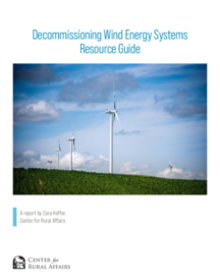Wind electricity generation has grown significantly, with total annual U.S. electricity generation from wind energy increasing from about 6 billion kilowatt hours (kWh) in 2000 to about 380 billion kWh in 2021. Decreasing wind turbine installation costs over the past decade have created more opportunities for wind development. With advances in technology, the cost of wind turbine installation is down more than 40% since the peak in 2010, which means lower installation and energy production costs. Wind energy provided 10% of total electricity nationwide in 2022. This included more than 60% of the power in Iowa and more than 40% of power in South Dakota, Kansas, and Oklahoma. Additionally, with the passage of the Inflation Reduction Act in 2022, forecasts for land-based wind energy installations in 2026 have increased nearly 60% from about 11,500 megawatts (MW) to 18,000 MW, which is enough to power an added two million homes.
Wind energy offers numerous benefits to rural communities. Wind development provides tax revenue for local communities, new job opportunities, and a low-cost, reliable energy source. Land for large wind projects is typically leased, which can provide an important source of rental income to landowners. In 2021, wind projects delivered $2 billion in state and local tax payments and land-lease payments. Additionally, wind turbine service technician is one of the fastest growing jobs in the country with the amount of people in this position expected to increase by 45% over the next decade (2022 to 2032).
Wind energy also provides production tax payments to counties. Each year, the Minnesota Department of Revenue releases a report detailing production taxes paid by wind and solar projects to the counties that host them. In 2022, the report shows that 28 Minnesota counties received more than $16.8 million in wind production tax revenue. Lincoln County, Minnesota, was the leader, receiving $3.8 million from 640 towers in the county.
Wind energy projects can make a positive economic contribution by offsetting energy costs. Distributed wind turbines can be used to directly offset customer electricity usage, a concept called net metering, which allows customers to receive money back on their electricity bills when their solar or wind power systems generate more electricity than is used on-site. Wind development also provides additional tax revenue to fund county services like schools, infrastructure, and emergency medical services.
To take advantage of the potential benefits of wind energy, county officials are responsible for enacting siting or zoning standards that help capture the benefits of new development while ensuring projects are built in a way that works best for local communities. One way this can be done is through planning for decommissioning. With the rise in wind development, it is prudent for counties to create a plan for decommissioning projects once they reach the eventual end of their life. A well-balanced ordinance will provide clear expectations and guidance for when and how decommissioning projects will take place.


